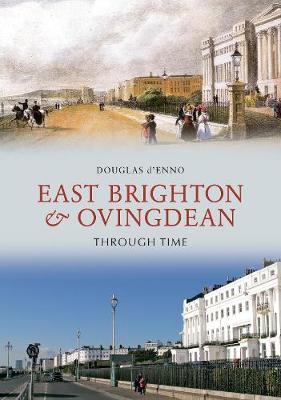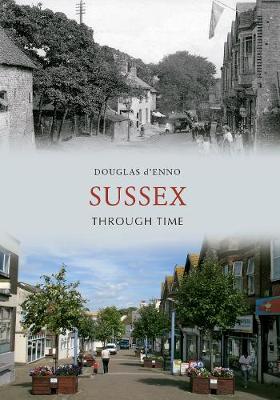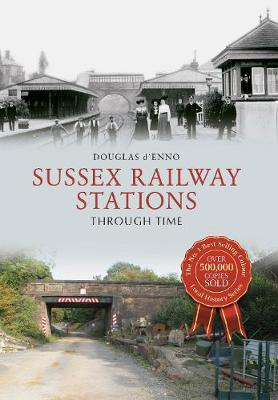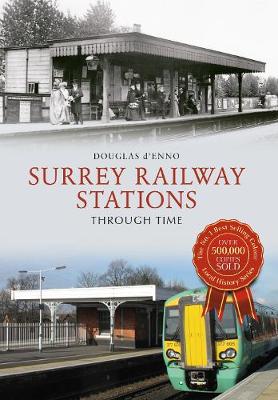Through Time
7 total works
This volume takes the reader on a carefully planned tour of a large and diverse segment of Brighton, using illustrations which in many cases have never previously been published in a book. Unusually for a 'then and now' study, early prints and colour paintings are also featured (that by Edward Fox on the front cover is an example) and contrast all the more sharply with scenes of the present day. The journey takes in the three major, parallel roads that traverse East Brighton then proceeds north, via Queen's Park, to Race Hill. Views of the various estates built to provide much-needed new housing for an expanding Brighton follow. A return is made to the coastal portion with stunning and sometimes rare views of Black Rock and the Marina. The images then take us eastward through Roedean to Ovingdean, a once sleepy farming village now transformed into a suburb of desirable residences.
This companion volume to Sussex Coast Through Time is unique in being the first 'then and now' book to portray the numerous and diverse communities of East and West Sussex through rich sepia and stunning colour images. Most of the early pictures have never previously been published and include a number of rarities that can only now be widely enjoyed. Far from simply depicting street scenes, the focus occasionally shifts, with suitable background, to an event, a group of buildings or perhaps even simply a shop or house to illustrate local change - for better or worse - down the years. Sussex Through Time is an important addition to the literature on Sussex and forms a valuable and long-awaited comparative record of most of the settlements lying within this extensive county.
Stretching for some 90 miles from the Kent boundary near Camber Sands with its sand dunes to Thorney Island within the sheltered waters of Chichester Harbour, the Sussex coast presents a rich variety of features, from bustling resorts to oases of calm and isolation. This is the first volume to depict this extraordinary coastline from a social history perspective. Readers will search in vain for views of, say, Beachy Head and the Cuckmere Valley cottages, as so frequently depicted elsewhere. Instead, the rare early images and their modern counterparts have for the most part never been published in any book. They record, among many other sights, vanished landscapes and buildings (including 1930s swimming pools, holiday camps and elegant hotels), climatic catastrophes, lost transport systems and even a murder site.This is a remarkable visual treat for anyone wishing to know more about the coastline of Sussex in all its spectacular variety.
It was in 1841 that the London & Brighton Railway constructed the line from Norwood (linking with the London & Croydon Railway) to the coast. The lines built between 1841 and 1868 formed a comprehensive countywide network, extending from Three Bridges to Midhurst and Chichester in the west and (via the South Eastern Railway) from Tunbridge Wells to Bexhill, thence to Rye, in the east. The county's coastal stations yield their own interesting story. Apart from the stations on main routes, those on branch lines and wayside halts are also included.
In this book, Douglas d'Enno explores the absorbing and sometimes colourful story of one county's railway stations. The older photographs feature early postcards and carefully selected images from railway archives and publications. When juxtaposed with their present-day equivalents, the extent of the change in these facilities for rail passengers can be fully appreciated.
In this book, Douglas d'Enno explores the absorbing and sometimes colourful story of one county's railway stations. The older photographs feature early postcards and carefully selected images from railway archives and publications. When juxtaposed with their present-day equivalents, the extent of the change in these facilities for rail passengers can be fully appreciated.
Rottingdean Through Time is a unique insight into the illustrious history of this part of the country. Reproduced in full colour, this is an exciting examination of Rottingdean, the famous streets and the famous faces, and what they meant to the people of Rottingdean throughout the 19th and into the 20th Century. Looking beyond the exquisite exterior of these well-kept photos, readers can see the historical context in which they are set. Through the author's factual captions for every picture, and carefully-selected choice of images, the reader can achieve a reliable view of the town's history. Readers are invited to follow a timeline of events and watch the changing face of Rottingdean, as Douglas d'Enno guides us through the town's streets. There is something for everyone here, whether they have lived in the area all their lives, or whether they are just visiting this fabulous town. It also shows how photography has continually evolved to keep up with an ever-changing society.
This companion volume to the author’s successful Sussex Railway Stations Through Time focuses in vivid detail on the stations located within the densely populated county of Surrey, an area largely unaffected by the drastic cuts of the 1950s and 1960s.
Both station interiors and exteriors are depicted and the comparative views between early and contemporary buildings and infrastructure provide a fascinating insight into social and architectural change.
The first public railway to operate in England (albeit horse-drawn) was opened in this county in 1803. The 8-mile-long narrow gauge Surrey Iron Railway carried goods from Wandsworth to Croydon for over forty years from the factories and businesses which mushroomed during those pivotal years of industrial and commercial development.
Unlike in Sussex, where the London, Brighton & South Coast Railway reigned supreme, Surrey was criss-crossed by lines operated by not only that company but also by the South Eastern Railway and the London & South Western Railway. Their uneasy co-existence occasionally flared into serious disputes over territories. Today, by contrast, four operators manage this complex and important network in a spirit of harmony.
Readers will enjoy the early images, many previously unpublished, of stations in this volume. They depict a lost era and pace of life and, displayed in careful contrast with their present-day equivalents, constitute an important pictorial contribution to the history of railways south of London.
Both station interiors and exteriors are depicted and the comparative views between early and contemporary buildings and infrastructure provide a fascinating insight into social and architectural change.
The first public railway to operate in England (albeit horse-drawn) was opened in this county in 1803. The 8-mile-long narrow gauge Surrey Iron Railway carried goods from Wandsworth to Croydon for over forty years from the factories and businesses which mushroomed during those pivotal years of industrial and commercial development.
Unlike in Sussex, where the London, Brighton & South Coast Railway reigned supreme, Surrey was criss-crossed by lines operated by not only that company but also by the South Eastern Railway and the London & South Western Railway. Their uneasy co-existence occasionally flared into serious disputes over territories. Today, by contrast, four operators manage this complex and important network in a spirit of harmony.
Readers will enjoy the early images, many previously unpublished, of stations in this volume. They depict a lost era and pace of life and, displayed in careful contrast with their present-day equivalents, constitute an important pictorial contribution to the history of railways south of London.
Perched atop the picturesque chalk cliffs of Britain's South Coast, Saltdean is an East Sussex town with a rich and fascinating history. Until 1924, Saltdean and the surrounding area was open farmland, but the area quickly became a prosperous village. Over the years, this coastal village has seen smugglers and shipwrecks, as well as undergoing development as a thriving seaside resort. With a beautiful shingle beach and picturesque promenade, the area remains popular with visitors both from nearby Brighton and across the south of England. Using a mixture of old and new images, author Douglas D'Enno tells the story of Saltdean and its environs. Featuring local landmarks such as Saltdean Lido and the former Grand Ocean Hotel, Saltdean & District Through Time aims to reawaken memories in longstanding residents and pique the curiosity of newcomers to the area.






